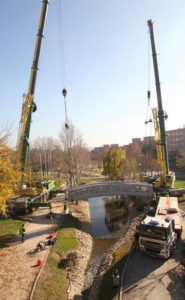
One of the major industries in which additive manufacturing technology is involved is construction. There are many building projects that are developed and being developed with 3D printing. The 3D printed pedestrian bridge, which is a first among these projects, collects everyone’s liking with its solidity and stylish design.
3D is an advantage over traditional methods both in design and materials, many buildings such as villas and offices are built with it. The 3D pedestrian bridge, the latest example of these studies, revealed that this technology is now a reliable industry to use in public buildings.
The 3D bridge in Alcobendas, Spain, has so far been the only 3D printed bridge made entirely of concrete, and has become an important part of the additive manufacturing and construction sectors. The official opening of the bridge, which is about 12 meters long and 1.75 meters wide, was carried out by Alcobendas city authorities on 14 December 2016. The bridge, which is the product of an R&D operation for about 15 years, was produced with a D-Shape printer with binder-jetting technology, which had previously manufactured a house.

The design of the bridge; in Castilla La Mancha Park Alcobendas; was made by the Institute of Advanced Architecture of Catalonia. Consisting of 8 separate parts; the construction of the bridge with the Spanish engineering company Accinona is also noteworthy with its natural and elegant appearance. The world’s first 3D bridge is also trusted by the green production these days; when 3D, like every sector, is putting forward the environmentally friendly and sustainable features. Recyclable raw materials are used for the bridge, which is also environmentally friendly in the construction process. Since 3D printed structures can be produced as raw materials without molds, an extra molding process is not needed; and both cost and time are gained. Alcobendas municipal authorities making statements in this context; stated that they prevented waste, energy and resource consumption to a maximum extent during this very extensive construction process.
3D pedestrian bridge
This bridge; which shows the design flexibility provided by the 3D technology with its indented surface; attracted much attention from the city people. The bridge is expected to inspire new public buildings to be formed in 3D with its image and solidity; in terms of cost also saves the city. With this project, which has an echo in all Europe, not just in Spain; other European countries are expected to try to build 3D public buildings. In addition to the structure that inspired the 3D construction segment in this direction; It is also announced that a 3D bridge construction is planned in Amsterdam using stainless steel material.
